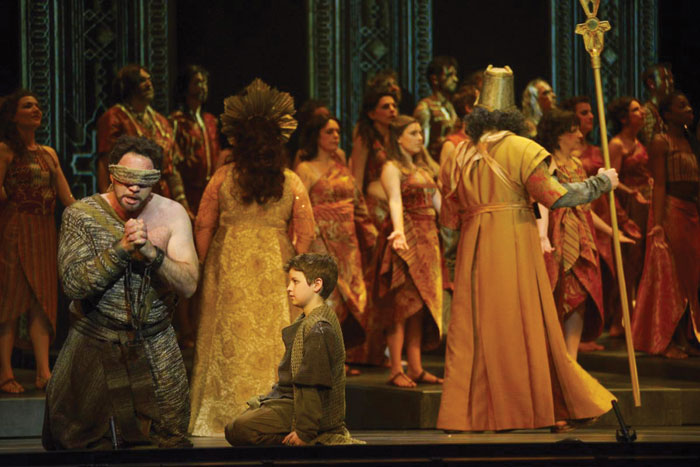As part of their 2014-2015 season, l’Opéra de Montréal produced Camille Saint-Saëns’ Samson and Delilah, a biblical tale of lovers’ deceit and the might of God. Sung entirely in French, Samson and Delilah tells the story of the Hebrew Samson (Endrik Wottrich), who used his God-given strength to free the Hebrew people from capture by the Philistines, only to be taken hostage yet again—both figuratively and literally—by the beautiful Philistine princess, Delilah (Marie-Nicole Lemieux).
The plot, as one could guess, is weak, if not simply boring. An operatic adaptation of a biblical story does not provide much in the way of excitement, and while each song sounds incredible to Saint-Saëans’ credit, little is gained by following the translation provided on a screen located above the stage. That advice goes for double in terms of the negative effect of taking your eyes away from the set for even a moment. Truly, the credit for what made this performance so incredible should be awarded to set designers Anick La Bissonnière and Eric-Olivier Lacroix, whose ingenuity in using multiple pillars with moving projections made for a simplistic yet awe-inspiring experience.
In terms of this production’s flaws, one does not have to look farther than Act I, which dragged along in spite of the skill of both the orchestra, conducted by Jean-Marie Zeitouni, and the chorus. Admittedly, Delilah’s entrance towards the end of the act provided a much-welcomed change of pace, since her costume for Act I finally ushered in the opulence one would expect in dealing with the rulers of Israel. The chorus, however, deserves particular amounts of praise, providing the best songs throughout, particularly in Act III when Samson is mocked. This is not to detract from the main cast; the skill of Wottrich and Lemieux hits its prime in Act II with the lovers’ duet—Samson on his knees crooning “Dalila, je t’aime!” as Delilah rebuts with claims of cowardice. This scene too succeeded in displaying director Alain Gauthier’s skill in making the most of the minimalist set design. In this particular scene, always having Samson either positioned lower than Delilah—a feat given Wottrich’s menacing size, accomplished in part by the tilted stage—or left in her shadow added to the drama of the whole affair.
Despite the clear talent of the main cast, chorus, and orchestra, it was ultimately the beauty of the set in combination with the contrasting elegance of the costumes that stole the show from beginning to end, making an all-encompassing performance even in scenes where the plot was noticeably lacking.
This was particularly embodied in Act III, when, in the Philistine temple, the chorus seated themselves facing the pillars upon which was projected a scene of a man and woman dancing maked in black and white. The scene itself was odd in its abrupt entrance and exit, but the soft lighting splayed across the cast, picking up the glow of the gold jewels in which they were adorned, as blasts of colour emitted from the projectors created a cinematic experience, as if we had been moved from the biblical retelling into a modern ballet.
As a whole, Samson and Delilah was beautiful in its production, using light imagery and a re-imaging of simple themes to create a visual experience as bold as the performers’ voices, bringing a relatively flat plot to life.
Samson and Delilah will be playing to a sold-out crowd at the Opéra de Montréal’s Wilfird Pelletier Hall Jan. 27, 29, and 31. Visit www.operademontreal.com to see the schedule for future events.








